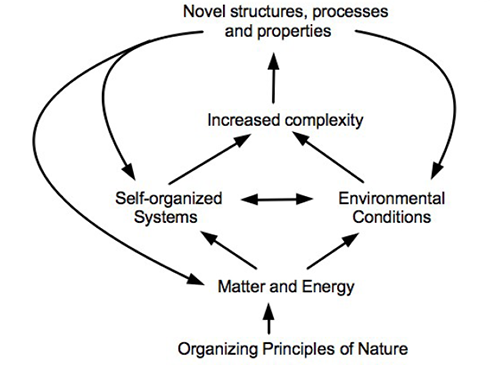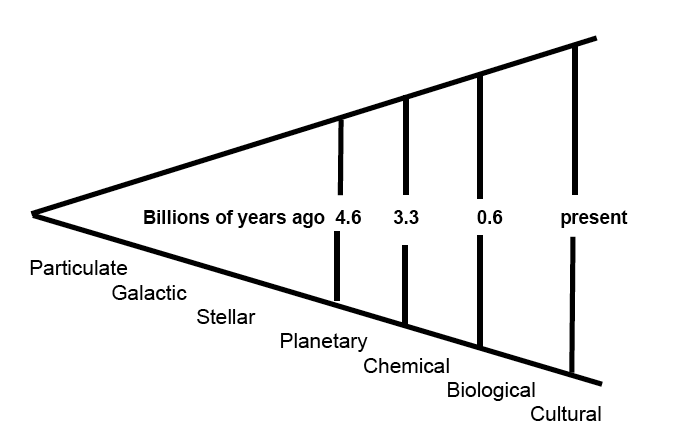14. Emergent Evolution
Background
Evolution as used here is more than Darwinian. It is not limited to living organisms but rather incorporates them and relates to the formation of everything.

Tracing through the diagram above: Everything is based on the organizing principles of nature. They organize matter and energy from which self-organized systems and environmental conditions arise. Those products tend to produce increased complexity and out of that increased complexity novel structures, processes and properties emerge.
The novelties have feedback effects on matter and energy which can result in new self-organized systems of further increased complexity. They also tend to produce changes in the environmental conditions. This feedback process is self sustaining as long as there is input of energy. It brings new things into the universe.
That is not to say that all systems behave in this way. That other great tendency of nature embodied in the 2nd Law can never be forgotten. Most systems respond to environmental change by becoming more disorganized and less complex. Stars as well as living things die. In the long run of the universe it is entropy that always wins.
Those new structures or processes that successfully produce other structures or processes tend to continue to exist. The products are, as it were, the next generation of things. Although entropy always trumps organization it does not nullify the real successes of emergent evolution.
Definitions
Emergence – the concept that there is a tendency in nature for matter and energy to spontaneously form new and more complex combinations with new and unexpected properties.
Evolution – a sequence of developmental changes that produce different forms, behaviors and concepts from previously existing ones. The new forms, behaviors and concepts continue to exist if they successfully work or function.
Discussion
The co-evolution of organisms and the environment
Just by its presence very living thing affects its environment in some way. In a system that contains more than one kind of living organism the environment in which they all live is affected in more than one way. Environmental change is made more complex. There is a co-evolution process at work where environmental change influences how species develop and organisms change the environment. A prime example is the addition of gaseous oxygen to the Earth's early atmosphere by the action of cyanobacteria. The oxygen in the atmosphere triggered vast changes in animal species.
Today any ecosystem consists of a multitude of sub-systems of organisms of different species. Each of these affects the surroundings in subtile and profound ways and vastly complicates the environment. New niches may be created that provide a home for new species. In effect each new species produces an environmental stress that can set the stage for other new species. Emergence is spontaneous and self-sustaining.
It is not to be overlooked that although environmental change engenders pressures toward the emergence of the new it is also an agent of elimination of the old. The appearance of a new species (humankind, for example) may so alter the environment as to cause a loss of species diversity which decreases natural complexity. Such is the world we are living in right now. However, our new human made environment brings about new constructions of a different sort, i.e. cities, transportation systems, or communication systems. These, in their own way, increase overall complexity.
Emergent evolution and civilization
No one will deny that today’s industrial/technilogical culture is vastly more complex than the culture of centuries ago. Contrast a village system based upon a farming economy relying on animal energy with a modern cosmopolitan system with its machines and electronic technology. Whence comes this increase in complexity? The diagram on the previous page may help to explain part of the process.
For one example, an increase in population can provide the environmental stress that stimulates the self-organization of food delivery systems to towns and cities. Markets develop with new properties. Entrepreneurship, capitalism, competition, contractual obligations are but a few of the new processes that emerge. Financial credit systems follow. Banking institutions and legal systems develop. As new ways of food storage, preservation and transportation are invented the physical dimensions of the food delivery system enlarges.
Each one of these changes, like an increase in the number of niches in an ecosystem, provides the opportunity for new activities, jobs, and specialists among the workers. The necessity for increased education arises and educational systems emerge.
Novelty drives out the old
If a species is less able to cope with its new environment or if it is less efficient in its use of energy it tends toward extinction. A new species that uses that same niche will drive out the old. New inventions in an industrialized environment act in a similar way. The internal combustion engine removed the horse from its role as a principal source of mechanical energy and changed it to that of a pet in industrial countries. The engine was stronger, more efficient, did not get weary and required less care. The horse drivers, harness makers, blacksmiths, whip, buggy and wagon makers disappeared. But the internal combustion engine moved civilization to new levels of complexity. In addition to creating new industries and professions, it promoted the organization of vast highway systems, intricate traffic control systems, and gasoline service systems. A more complicated story could be told of the influence of the use of electrical energy and the emergence of our electronic age.
The increased complexity of our civilization is, in its way, a natural outcome and the result of many self-organizing systems. Not all of it but much of it is not a product of human planning. In fact, in the name of efficiency, much time and energy is spent in trying to reduce the complexity of many aspects of human life. New products and processes are continuously being developed. Partially because of this increased complexity of technology the standard of living has risen and the average length of human life has been extended. Increased technological complexity has also expanded the development of human potential by growth in the range of actions available. That is not to say that increased technology is in all ways good. Environmental degradation, the fast pace of modern life, and the increased ferocity of war are some of the downside effects of our technological age.
As more complex systems emerge from simpler ones they can, metaphorically, be considered to be on a step up or onto a higher level. It then may be stated that even in human affairs a natural process of self-organization to higher levels emerges out of lower ones and the evolutionary process of civilization is one of emergence toward greater complexity.
System evolution in an expanding universe

Based on a NASA chart Produced by Wright Center for Science Education, Tufts University